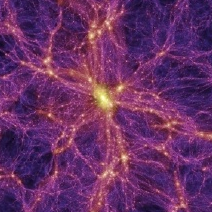In the early 1980’s, Mordehai Milgrom proposed that Newton’s law of gravity could be modified as a replacement for dark matter. Three researchers now claim that gravity in the regime of extremely small accelerations fail, and that they have proven it.
Modified Newtonian Dynamics (MOND) were proposed to explain the galaxy rotation problem. Unexpectedly, when it was first observed, the velocity of rotation of galaxies appeared to be uniform: Newton’s theory of gravity predicts that the farther away an object is from the center of the galaxy it belongs to, the lower its velocity will be (for example, the velocity of a planet orbiting a star decreases as the distance between them increases). These observations gave birth to the idea that a halo of invisible stuff was surrounding each galaxy: dark matter.
MOND is another way to model the observed uniform velocity. In a few words, MOND proposes that when the acceleration due to gravity goes below a fixed value, Newton’s law doesn’t work anymore. And this happens to match the observations much better than dark matter!
So, why is the vast majority of cosmologists sticking to dark matter? Because although MOND models very well the rotation curves of galaxies, that’s actually the only thing it does.
I’ll start with an empirical example: the Bullet Cluster, a system of two colliding galaxy clusters (in visible light in the image above; in a composite image below). Dark matter is required to explain the phenomenon of gravitational lensing observed in the cluster. MOND alone cannot explain it.

MOND predictions concerning large-scale structures, such as galaxy clusters, are very far from being good at reproducing observations. Dark matter does it pretty well.
Finally, a relativistic version of MOND, called TeVeS, seems to be able to explain gravitational lensing, structure formation, and it can also explain the cosmic microwave background anisotropies (more or less…). But it comes with a surprise: although TeVeS doesn’t require cold dark matter (which travels at low speeds), it needs hot dark matter (which travels at relativistic speeds) to work… And once again, it is anyway quite far from fitting the data as well as dark matter.
These observations don’t mean that gravity cannot be modified, but there is no evidence for it and it seems extremely difficult to avoid dark matter.
A common criticism made against MOND is that it is not possible to test it, or at least nowhere near our solar system: the regime of acceleration required is too low. X. Hernandez, M. A. Jimenez and C. Allen have now proposed a new test: such regimes can be observed with a particular type of stars, wide orbit binary stars. It becomes interesting when they actually perform their test on a statistical survey. According to them, this test proves that classical gravity fails in the weak acceleration regime!
For various reasons, including the ones mentions above, as well as some related to the content of the paper itself, I must say that I have a few serious doubts about their results. It is for sure too early to claim that gravity exhibits a change of regime at very small acceleration scales, and even if it did, I can’t see how this would definitely rule out dark matter. Anyway, if this test is reliable, this offers a new way to check what happens in low acceleration regimes, and it will be interesting to wait for further studies.
